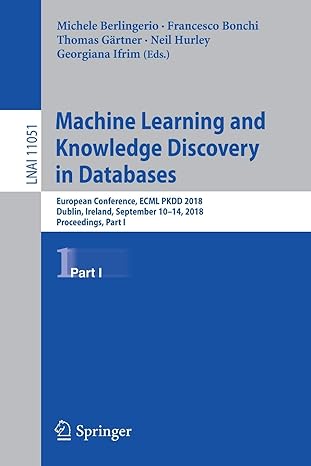Answered step by step
Verified Expert Solution
Question
1 Approved Answer
Polymorphism exercise The purpose of this exercise is to practice writing code that uses the Object - Oriented Programming principle of polymorphism. Learning objectives After
Polymorphism exercise
The purpose of this exercise is to practice writing code that uses the ObjectOriented Programming principle of polymorphism.
Learning objectives
After completing this exercise, you'll be able to:
Explain the concept of polymorphism and how it's useful
Understand where inheritance can assist in writing polymorphic code
State the purpose of interfaces and how they're used
Use polymorphism through inheritance using ISA relationships
Use polymorphism through interfaces using CANDO relationships
Getting started
Open the polymorphism exercise in IntelliJ.
Complete the appropriate classes to satisfy the requirements.
Evaluation criteria and functional requirements
The project must not have any build errors.
Code is in a clean, organized format.
Code is appropriately encapsulated.
Code uses polymorphism appropriately to avoid code duplication.
The code meets the specifications defined in the remainder of this document.
Bank customer application
Notes for all classes and interfaces
X in the set column indicates it must have a setter.
"Derived" in the set column indicates the attribute is a derived property and don't require a setter.
Instructions
This code extends from the previous unit's exercise. The bank account classes work well, but now the bank needs to calculate a customer's total assets to assign them VIP status if they have $ or more in assets at the bank.
The bank is also introducing credit cards. Since credit cards aren't strictly bank accounts that store money, they don't inherit from the BankAccount class. However, you must still account for them in the VIP calculation.
For this exercise, you'll add new features to the code to create a BankCustomer class that has multiple accounts. You'll also create a new type of account: a credit card account. A credit card account isn't a BankAccount, but you must store it with the customer as one of their accounts. To do this, you need to create a new interface that specifies that an object is "accountable" and has a getBalance method.
Account Class Diagram
For this exercise, you'll:
Add a new method to allow customers to transfer money between BankAccounts.
Create a new interface called Accountable.
Make BankAccount implement Accountable.
Create a new class called CreditCardAccount that's also Accountable.
Create a BankCustomer class that has many Accountable objects.
Add an isVip method to BankCustomer.
Step One: Add a new transferFunds method to transfer money between BankAccounts
Add the following method to allow BankAccounts to transfer money to another BankAccount. Where would you add this method to make sure it works the same for all BankAccounts, including SavingsAccount and CheckingAccount?
Method Name Return Type Description
transferFundsBankAccount destinationAccount, int transferAmount int Withdraws transferAmount from this account and deposits it into destinationAccount. Returns the new balance of the "from" account.
All tests in StepTransferFundsTest pass when this section is complete.
Step Two: Create the Accountable interface and make BankAccount implement it
The Accountable interface means that an object can be used in the accounting process for the customer.
Method Name Return Type Description
getBalance int Returns the balance value of the account in dollars.
Add the Accountable interface to BankAccount. This makes BankAccount, and all the classes that inherit from BankAccount, "accountable" classes.
All tests in StepAccountableTest pass when this section is complete.
Step Three: Implement a new CreditCardAccount class
A CreditCardAccount isn't a BankAccount but "cando Accountable.
Constructor Description
CreditCardAccountString accountHolderName, String cardNumber A new credit card account requires an account holder name and card number. The debt defaults to a dollar balance.
Attribute Name Data Type Get Set Description
accountHolderName String X The account holder name that the account belongs to
cardNumber String X The credit card number for the account.
debt int X The amount the customer owes.
balance int Derived Required property of the Accountable interface. Returns the debt value as a negative number.
Method Name Return Type Description
payint amountToPay int Subtracts amountToPay from the amount owed. Returns the new total amount owed. amountToPay must be greater than zero.
chargeint amountToCharge int Adds amountToCharge to the amount owed. Returns the new total amount owed. amountToCharge must be greater than zero.
Note: Be sure to implement the interface. The balance for the accounting must be the debt as a negative number.
All tests in StepCreditCardTest pass when this section is complete.
Step Four: Implement the BankCustomer class
Implement the BankCustomer class. A bank customer has a list of Accountables.
Attribute Name Data Type Get Set Description
Step by Step Solution
There are 3 Steps involved in it
Step: 1

Get Instant Access to Expert-Tailored Solutions
See step-by-step solutions with expert insights and AI powered tools for academic success
Step: 2

Step: 3

Ace Your Homework with AI
Get the answers you need in no time with our AI-driven, step-by-step assistance
Get Started


